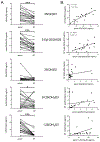Serum and synovial fluid vitamin D metabolites and rheumatoid arthritis
- PMID: 30611909
- PMCID: PMC6444051
- DOI: 10.1016/j.jsbmb.2018.10.008
Serum and synovial fluid vitamin D metabolites and rheumatoid arthritis
Abstract
Vitamin D-deficiency has been linked to inflammatory diseases including rheumatoid arthritis (RA). Studies to date have focused on the impact of serum 25-hydroxyvitamin D3 (25(OH)D3), an inactive form of vitamin D, on RA disease activity and progression. However, anti-inflammatory actions of vitamin D are likely to be mediated at sites of RA disease, namely the inflamed joint, and may involve other vitamin D metabolites notably the active form of vitamin D, 1,25-dihydroxyvitamin D3 (1,25(OH)2D3). In the current study serum and synovial fluid samples from n = 20 patients with persistent RA and n = 7 patients with reactive arthritis (ReA) were analysed for multiple vitamin D metabolites. Serum data for RA and ReA patients were compared to healthy controls (HC). There was no significant difference between RA or ReA patients relative to HC for 25(OH)D3, 24,25(OH)2D3, 1,25(OH)2D3 or 25(OH)D2. However, 3-epi-25(OH)D3 was significantly lower in RA and ReA patients compared to HC (p < 0.05). All vitamin D metabolites, apart from 25(OH)D2, were lower in SF compared to serum, and SF 1,25(OH)2D3 was unquantifiable in 13/20 RA and 4/7 ReA samples. SF 25(OH)D3, 3-epi-25(OH)D3 and DBP correlated inversely with swollen joint score, and serum 25(OH)D2 and SF DBP correlated directly with C-reactive protein levels. These data indicate that serum 25(OH)D3 provides only limited insight into the role of vitamin D in RA. Alternative serum metabolites such as 3-epi-25(OH)2D3, and SF metabolites, notably lack of SF 1,25(OH)2D3, may be more closely linked to RA disease severity and progress.
Keywords: Free vitamin D; Inflammatory disease; Rheumatoid arthritis; Serum; Synovial fluid; Vitamin D; Vitamin D binding protein.
Copyright © 2019 Elsevier Ltd. All rights reserved.
Conflict of interest statement
Conflict of interest
The authors declare no conflict of interest.
Figures




References
-
- Alegre ML, Noel PJ, Eisfelder BJ, Chuang E, Clark MR, Reiner SL, Thompson CB, Regulation of surface and intracellular expression of CTLA4 on mouse T cells, Journal of immunology (Baltimore, Md. : 1950), 157 (1996) 4762–4770. - PubMed
-
- Hewison M, Antibacterial effects of vitamin D, Nature reviews. Endocrinology, 7 (2011) 436. - PubMed
-
- Hewison M, An update on vitamin D and human immunity, Clin Endocrinol (Oxf), 76 (2012) 315–325. - PubMed
-
- Kreutz M, Andreesen R, Krause SW, Szabo A, Ritz E, Reichel H, 1,25-dihydroxyvitamin D3 production and vitamin D3 receptor expression are developmentally regulated during differentiation of human monocytes into macrophages, Blood, 82 (1993) 1300–1307. - PubMed
Publication types
MeSH terms
Substances
Grants and funding
LinkOut - more resources
Full Text Sources
Medical
Research Materials

